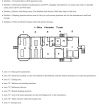A couple of problems with this idea.The RCAF bought the CF104 for the NATO nuclear strike then conventional attack role based in Germany, not for air defence in Canada as part of NORAD.
I'd suggest that the Canadians buy 60 - 75 Arrow Mk2 for the NORAD role instead of 66 CF101 and 56 BOMARCs then ~150 multi-role Arrow Mk3 for the NATO role instead of 200 CF104s. A 200+ units production run would make the whole project viable and would have lower support overheads than having a fleet of CF101s and another fleet of CF104s
First and foremost, the "Mark 3" Arrow does not exist, other than as a napkin sketch. The amount of engineering that would be required to redesign this aircraft (to meet a role it was never intended for) would be staggering. As it was, the interceptor was already way behind in its flight testing schedule; all available resources were being dedicated to getting this back on track at the point of project termination.
Also, a huge twin engine "pure" Delta is probably the worst planform you could think of to turn into a low level penetration/strike aircraft. The ride down in the weeds would be virtually intolerable for the crew at high subsonic speeds.
Read a little about the usaf's testing with the B-58 "Hustler" at low level/high subsonic. The arrow was not quite as large as the hustler, but it was definitely close.
As this was right at the moment that NATO was realizing that the Soviets had built a rather formidable SAM capability against high flying aircraft, everything was being refocused towards low level penetrations.
I would think that by the time you could get all of the engineering and redesign work completed to make this into a marginally acceptable strike aircraft, you're looking at the mid-60s, at best.
Using the existing Mark II design in NATO (as an all weather fighter, a la CF-100) would likewise be a difficult transition for the design (that had evolved by 1959). The AIM-4, by default the primary air-to-air weapon to be carried, was simply not suitable for use against manoeuvring targets. Plan B would have to be the AIR-2 Genie. I'd love to see the reaction of the West German government with regards to that one.
Another note on a different part of the discussion. The RCAF/GOC never "bought" the CF-101 or the AIR-2 that it carried. These remained USAF property throughout their service lives in Canada. The RCAF paid life cycle costs on the engines, airframes, and avionics, all associated O&M expenses, and I believe we did actually buy our "own" AIM-4 Falcons. I may be wrong on that last part however. The BOMARC deal was a little more complicated but rather similar.
Canada provided manning and maintenance support for the large bulk of the US built radar installations located on Canadian territory in exchange. Also, the supply and maintenance aspects of the leases held by the USAF/SAC for bases on Canadian territory were involved during negotiations.
We stood down use of the Voodoo capability in 1984 and had to go through a considerable pile of hoops in order to keep a portion of the machines as museum pieces and gate Guardians.
They were still USAF property and had to be written off through the proper channels to allow for this.
Last edited:
